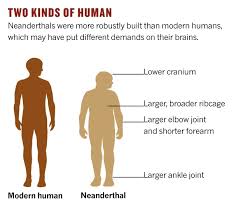Mating with relatives more common among Neanderthals
Saturday, April 26th, 2014 1:41:29 by Kashif Mirza
Neanderthals were not only different from us in body and brain, but also showed a distinct style of evolution. Those early inhabitants of Europe experienced more genetic changes in the shape of the skeleton, while modern humans have mutated more on behavior and pigmentation. Research conducted by the world’s leading fossil DNA, Svante Pääbo of the Max Planck Institute Leipzig, and an important contribution of the CSIC, is based on the comparison of the genomes of three Neanderthals in Siberia, Spain and Croatia, among themselves and with modern humans from Africa, Europe and Asia. And it also shows that the Neanderthal genetic diversity was lower than that of modern humans, and their populations were small and isolated.
Scientists have been deeply interested in the emerging discipline of ancient DNA. Apart from the lack of sufficiently well preserved Neanderthal remains, experts are facing more than 99 % of the DNA that comes from microbial origin, not to mention the ubiquitous contamination of genetic material to modern humans tend to confuse their experiments. Under the leadership of the great geneticist Svante Pääbo of the Max Planck Institute for Evolutionary Anthropology in Leipzig, biologists are slowly avoiding these pitfalls. Collaborating with him are Spanish scientists CSIC, Oviedo University and Pompeu Fabra (Barcelona) and the National Museum of Natural Sciences in Madrid. Of only three Neanderthals genomes sequenced to date, one comes from The Sidrón cave in Asturias, in a rare example of urgency and diligence of local science in genetics global forefront.
Researchers have also used the genome of a Denisovan, the enigmatic species that, in fact, would not have been discovered if not for the technical sequencing of ancient DNA, it is not much that remains of it except some fossils – found some years ago in the Denisova cave in the Altai Mountains, in Liberia, and a few genetic sequences that passed them to the current inhabitants of Asia. They have compared all nine modern populations: Yoruba Mandenka and Dinka, Africa; French, Sardinian and Italian Americans of European origin; Han and Dai, Asia; Oceania and gentoo. A spectrum of history and prehistory unparalleled to date.
With this material, XXI century geneticists can reach startling conclusions about early humans, as if they had a time machine. For example, the size of the stretches of homozygosity – fully mismatched DNA segments in the two chromosomes of each pair, which comes from the father and the mother has been revealed that mating among relatives was more common among Neanderthals compared to today.
They have also learned that the degree of genetic differentiation between Neanderthals was larger than exists today among Africans, Europeans and Asians. At the current viewer, all Neanderthals may seem the same, but you see it is not. Is expected, since Neanderthals were carrying hundreds of thousands of years campando by the Eurasian steppes, while our species is a relative newcomer to this world. In fact, most of the genetic variation among modern humans is not our , but we have inherited it from our African ancestors. Genetic way into the mists of time.
Short URL: https://www.newspakistan.pk/?p=43309

















